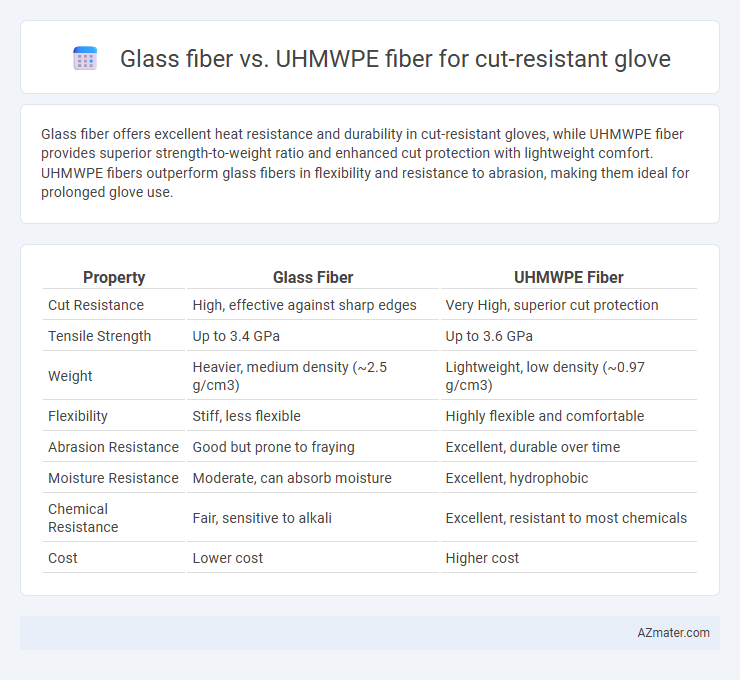Glass fiber offers excellent heat resistance and durability in cut-resistant gloves, while UHMWPE fiber provides superior strength-to-weight ratio and enhanced cut protection with lightweight comfort. UHMWPE fibers outperform glass fibers in flexibility and resistance to abrasion, making them ideal for prolonged glove use.
Table of Comparison
| Property | Glass Fiber | UHMWPE Fiber |
|---|---|---|
| Cut Resistance | High, effective against sharp edges | Very High, superior cut protection |
| Tensile Strength | Up to 3.4 GPa | Up to 3.6 GPa |
| Weight | Heavier, medium density (~2.5 g/cm3) | Lightweight, low density (~0.97 g/cm3) |
| Flexibility | Stiff, less flexible | Highly flexible and comfortable |
| Abrasion Resistance | Good but prone to fraying | Excellent, durable over time |
| Moisture Resistance | Moderate, can absorb moisture | Excellent, hydrophobic |
| Chemical Resistance | Fair, sensitive to alkali | Excellent, resistant to most chemicals |
| Cost | Lower cost | Higher cost |
Introduction to Cut-Resistant Glove Materials
Glass fiber and UHMWPE fiber are key materials used in cut-resistant gloves, each offering distinct protective qualities. Glass fiber provides excellent cut resistance and heat tolerance due to its high tensile strength and rigidity, making it suitable for handling sharp objects and hot surfaces. UHMWPE fiber delivers superior abrasion resistance with lightweight flexibility and high energy absorption, ideal for prolonged wear and enhanced dexterity in industrial applications.
Overview of Glass Fiber in Cut-Resistant Gloves
Glass fiber in cut-resistant gloves offers exceptional tensile strength and abrasion resistance, making it highly effective against sharp objects and rough surfaces. Its lightweight and heat-resistant properties enhance comfort and durability during prolonged use, optimizing worker safety in industrial environments. Glass fiber is often blended with other materials to improve flexibility while maintaining superior cut protection.
Overview of UHMWPE Fiber in Cut-Resistant Gloves
UHMWPE fiber, known for its ultra-high molecular weight and exceptional tensile strength, offers superior cut resistance compared to traditional glass fiber in protective gloves. Its lightweight nature enhances wearer comfort without compromising durability, making it ideal for industries requiring prolonged glove use. Enhanced abrasion resistance and resistance to chemical degradation further position UHMWPE as a leading material in advanced cut-resistant gloves.
Mechanical Properties Comparison: Glass Fiber vs. UHMWPE
Glass fiber offers high tensile strength and excellent heat resistance, making it suitable for cut-resistant gloves requiring durability under high temperatures. UHMWPE fiber provides superior impact resistance and exceptional cut performance due to its ultra-high molecular weight and low density, resulting in lighter, more flexible gloves. Comparing mechanical properties, UHMWPE surpasses glass fiber in tensile strength-to-weight ratio and abrasion resistance, while glass fiber excels in stiffness and thermal stability.
Cut Resistance Performance: Standards and Ratings
Glass fiber and UHMWPE fiber differ significantly in cut resistance performance for gloves, with UHMWPE often exceeding ASTM F2992 Level A5, offering superior protection against sharp objects. Glass fiber gloves generally meet ANSI/ISEA 105 cut level A3 to A4, providing adequate durability but less flexibility compared to UHMWPE. Both fibers are tested under standardized methods such as ISO 13997, influencing their selection based on required cut resistance ratings for industrial applications.
Comfort and Wearability: Flexibility & Breathability
Glass fiber offers high cut resistance but tends to be stiffer and less breathable, which can reduce overall comfort and flexibility in gloves. UHMWPE fiber provides excellent cut protection combined with superior flexibility and enhanced breathability, leading to better dexterity and extended wearability. Gloves made with UHMWPE fibers are preferred for applications requiring prolonged use without sacrificing comfort and ease of movement.
Durability and Longevity of Each Fiber Type
Glass fiber offers high tensile strength and excellent heat resistance, making cut-resistant gloves durable against sharp objects and abrasive surfaces. UHMWPE fiber stands out for its superior cut resistance combined with lightweight flexibility and resistance to moisture and chemicals, often resulting in longer glove lifespan under varied working conditions. While glass fiber gloves may degrade faster under repeated bending and exposure to chemicals, UHMWPE fibers maintain structural integrity, enhancing overall longevity in demanding environments.
Cost Efficiency and Affordability Analysis
Glass fiber offers a highly cost-efficient solution for cut-resistant gloves due to its lower raw material price and widespread availability, making it affordable for large-scale manufacturing. UHMWPE fiber, while providing superior cut resistance and lightweight durability, comes with a significantly higher price tag attributed to advanced production processes and specialized raw materials. When balancing cost efficiency and performance, glass fiber is typically preferred for budget-conscious applications, whereas UHMWPE suits premium gloves where enhanced cut protection justifies the increased expense.
Safety Considerations: Skin Irritation and Allergies
Glass fiber in cut-resistant gloves can cause skin irritation and allergic reactions due to its rigid, abrasive nature that may lead to discomfort and dermatitis. UHMWPE (Ultra-High-Molecular-Weight Polyethylene) fiber offers superior hypoallergenic properties and softer contact with the skin, reducing the risk of irritation and allergic responses. Selecting UHMWPE fiber enhances wearer comfort and safety by minimizing potential adverse dermatological effects during prolonged glove use.
Best Applications for Glass Fiber vs. UHMWPE Gloves
Glass fiber gloves excel in high-temperature environments and applications requiring excellent cut resistance with thermal protection, making them ideal for metal fabrication, glass handling, and industrial manufacturing. UHMWPE fiber gloves offer superior cut resistance combined with lightweight comfort and chemical resistance, suited for food processing, electronics assembly, and precision tasks requiring dexterity. Choosing between glass fiber and UHMWPE fiber gloves depends on whether heat resistance or enhanced flexibility and chemical protection are prioritized in the work environment.

Infographic: Glass fiber vs UHMWPE fiber for Cut-resistant glove
 azmater.com
azmater.com